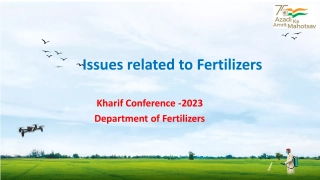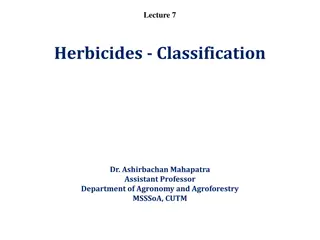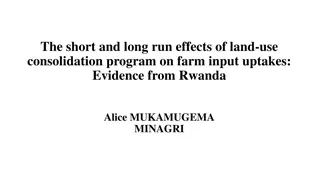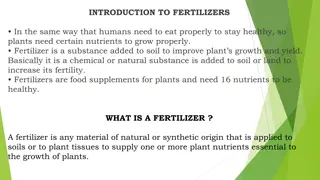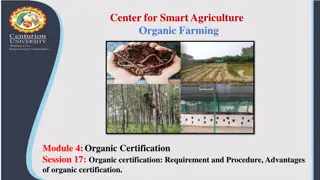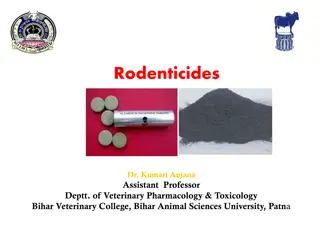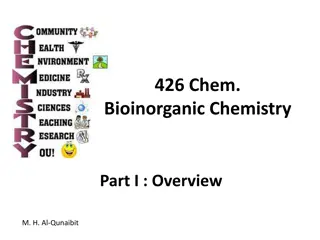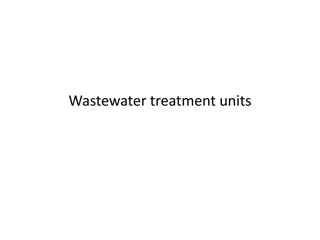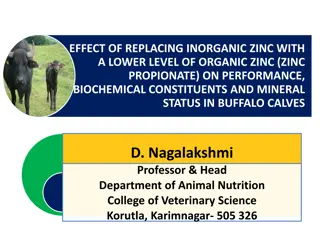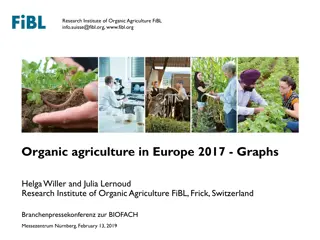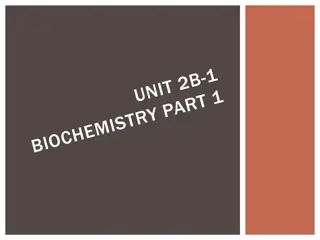
Essential Plant Nutrients and Their Functions in Agriculture
Discover the importance of essential plant nutrients in agriculture, including macronutrients and micronutrients. Learn about the functions of key nutrients like nitrogen and phosphorus, as well as how to identify deficiency symptoms for effective crop management.
Download Presentation

Please find below an Image/Link to download the presentation.
The content on the website is provided AS IS for your information and personal use only. It may not be sold, licensed, or shared on other websites without obtaining consent from the author. If you encounter any issues during the download, it is possible that the publisher has removed the file from their server.
You are allowed to download the files provided on this website for personal or commercial use, subject to the condition that they are used lawfully. All files are the property of their respective owners.
The content on the website is provided AS IS for your information and personal use only. It may not be sold, licensed, or shared on other websites without obtaining consent from the author.
E N D
Presentation Transcript
Fertilizers & Nutrients By: Johnny M. Jessup Agriculture Teacher/FFA Advisor
Essential Plant Nutrients Macronutrients Required in relatively large amounts. Micronutrients Required in small amounts. Minor or trace elements.
Macronutrients Fall into one of three categories: Non-Mineral Elements Primary Nutrients Secondary Nutrients
Non-Mineral Elements (C) Carbon (H) Hydrogen (O) Oxygen
Primary Nutrients (N) Nitrogen (P) Phosphorus (K) Potassium
Secondary Nutrients (Ca) Calcium (Mg) Magnesium (S) Sulfur
Micronutrients (Fe) Iron (Cu) Copper (Zn) Zinc (B) Boron (Mo) Molybdenum (Mn) Manganese (Cl) Chlorine
Function & Deficiency Symptoms of Nutrients
Nitrogen Function Promotes growth of leaves and stems. Gives dark green color and improves quality of foliage. Necessary to develop cell proteins and chlorophyll.
Nitrogen Deficiency Symptoms Sick, yellow-green color. Short stems, small leaves, pale colored leaves and flowers. Slow and dwarfed plant growth.
Phosphorus Functions Stimulates early formation & growth of plants. Provides for fast & vigorous growth and speeds maturity. Stimulates flowering & seed development. Necessary for the enzyme action of many plant processes.
Phosphorus Deficiency Symptoms Decrease in growth. Slow maturity. Older leaves are purplish color.
Potassium Functions Used to form carbohydrates & proteins. Formation and transfer of starches, sugars, & oils. Increases disease resistance, vigor, & hardiness.
Potassium Deficiency Symptoms Mottled, spotted, streaked or curled leaves. Scorches, burned, dead leaf tips & margins.
Calcium Functions Improves plant vigor. Influences intake & synthesis of other plant nutrients. Important part of cell walls.
Calcium Deficiency Symptoms Small developing leaves, wrinkled older leaves. Dead stem tips.
Magnesium Functions Influence the intake of other essential nutrients. Helps make fats. Assists in translocation of phosphorus & fats.
Magnesium Deficiency Symptoms Interveinal chlorosis. (Yellowing of leaves between green veins) Leaf tips curl or cup upward. Slender, weak stems.
Sulfur Functions Promotes root growth and vigorous vegetative growth. Essential to protein formation.
Sulfur Deficiency Symptoms Young leaves are light green with lighter color veins. Yellow leaves and stunted growth.
Iron Functions Essential for chlorophyll production. Helps carry electrons to mix oxygen with other elements.
Iron Deficiency Symptoms Mottled & interveinal chlorosis in young leaves. Stunted growth & slender, short leaves.
Copper Functions Helps in the use of iron. Helps respiration.
Copper Deficiency Symptoms Young leaves are small and permanently wilt. Multiple buds at stem tips.
Zinc Functions Plant metabolism. Helps form growth hormones. Reproduction.
Zinc Deficiency Symptoms Retarded growth between nodes (rosetted) New leaves are thick & small. Spotted between veins, discolored veins.
Boron Functions Affects water absorption by roots. Translocation of sugars.
Boron Deficiency Symptoms Short, thick stems tips. Young leaves of terminal buds are light green at base. Leaves become twisted & die.
Manganese Functions Plant metabolism. Nitrogen transformation.
Manganese Deficiency Symptoms Interveinal chlorosis. Young leaves die.
Molybdenum Functions Plant development. Reproduction.
Molybdenum Deficiency Symptoms Stunted growth. Yellow leaves, upward curling leaves, & leaf margins burn.
Chlorine Functions Essential to some plant processes. Acts in enzyme systems.
Chlorine Deficiency Symptoms Usually more problems with too much chlorine or toxicity than with deficiency. CHLORINE TOXICITY
Complete vs. Incomplete Complete Fertilizers Contain all 3 primary nutrients of nitrogen, phosphorus, & potassium. Examples: 10-10-10 15-30-15 20-5-20
Complete vs. Incomplete Incomplete Fertilizers DO NOT have all 3 primary nutrients. Examples: 20-0-0 0-20-0 12-0-44
Organic vs. Inorganic Organic Fertilizers Come from plant or animal matter & contain carbon compounds. Examples: Urea Sludge Animal Tankage
Organic vs. Inorganic Advantages of Organic Fertilizers Slow release of nutrients. Not easily leached from soil. Add organic components to growing media.
Organic vs. Inorganic Disadvantages of Organic Fertilizers Hard to get. Expensive. Not sterile. Low nutrient content.
Organic vs. Inorganic Inorganic Fertilizers Come from sources other than animals or plants . Chemical products.
Organic vs. Inorganic Advantages of Inorganic Fertilizers Can make desired ratio of nutrients. Lower cost. Easy to get
Organic vs. Inorganic Disadvantages of Inorganic Fertilizers No organic material. Possible chemical building up in growing media.
Soluble vs. Insoluble Soluble Fertilizer Dissolves in water & are applied as a liquid solution. Advantages Can fertilizer through the irrigation water in a process called fertigation.
Soluble vs. Insoluble Insoluble Fertilizer Includes granular & slow release fertilizers applied to the growing media.
Soluble vs. Insoluble Granular Fertilizer Relatively inexpensive Easy to find Slow Release Fertilizer More expensive than granular because it is coated. Gives a more uniform release of nutrients over time period.
Fertilizer Analysis & Ratio Analysis Expresses the percent by weight of nitrogen, phosphorus, & potassium. Ratio Is a comparison of primary nutrients 10-10-10 = 1:1:1 24- 8 -16 = 3:1:2
Methods of Applying Fertilizers

